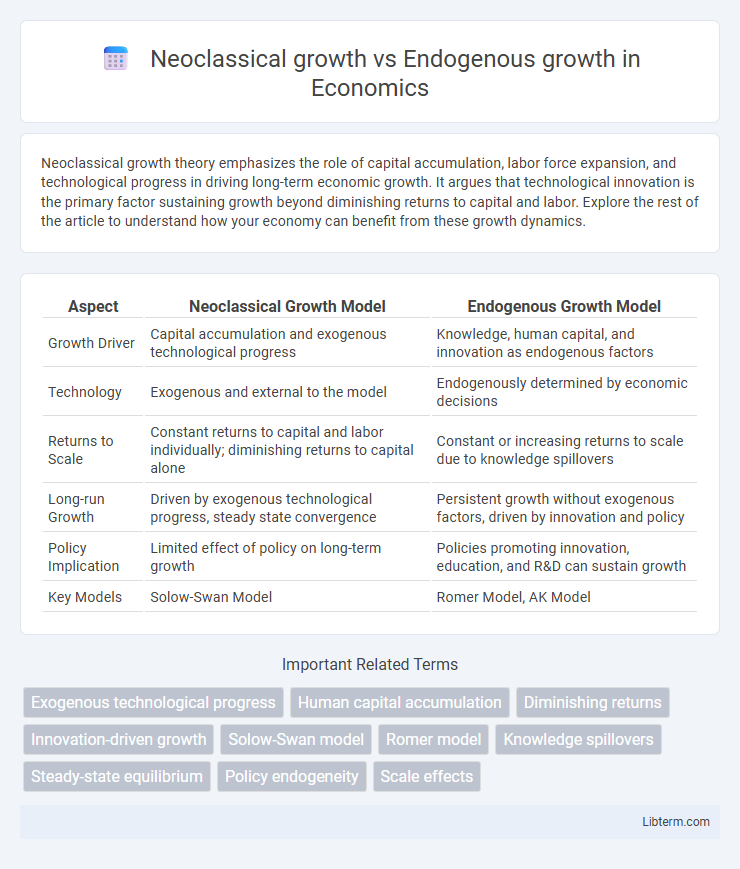Neoclassical growth theory emphasizes the role of capital accumulation, labor force expansion, and technological progress in driving long-term economic growth. It argues that technological innovation is the primary factor sustaining growth beyond diminishing returns to capital and labor. Explore the rest of the article to understand how your economy can benefit from these growth dynamics.
Table of Comparison
| Aspect | Neoclassical Growth Model | Endogenous Growth Model |
|---|---|---|
| Growth Driver | Capital accumulation and exogenous technological progress | Knowledge, human capital, and innovation as endogenous factors |
| Technology | Exogenous and external to the model | Endogenously determined by economic decisions |
| Returns to Scale | Constant returns to capital and labor individually; diminishing returns to capital alone | Constant or increasing returns to scale due to knowledge spillovers |
| Long-run Growth | Driven by exogenous technological progress, steady state convergence | Persistent growth without exogenous factors, driven by innovation and policy |
| Policy Implication | Limited effect of policy on long-term growth | Policies promoting innovation, education, and R&D can sustain growth |
| Key Models | Solow-Swan Model | Romer Model, AK Model |
Introduction to Economic Growth Theories
Neoclassical growth theory emphasizes exogenous technological progress as the primary driver of long-term economic growth, relying on diminishing returns to capital and labor. Endogenous growth theory, in contrast, highlights the role of internal factors such as human capital accumulation, innovation, and knowledge spillovers in sustaining growth without assuming technological change occurs outside the model. These theories form the foundation of modern economic growth analysis by explaining different mechanisms behind productivity improvements and income expansion.
Overview of Neoclassical Growth Model
The Neoclassical Growth Model, developed by Robert Solow, emphasizes capital accumulation, labor growth, and technological progress as key drivers of long-term economic growth. It assumes diminishing returns to capital and exogenous technological change, leading to a steady-state equilibrium where per capita growth depends solely on technological advancement. This contrasts with Endogenous Growth Theory, which incorporates technology and innovation as outcomes of economic decisions within the model.
Core Principles of Endogenous Growth Theory
Endogenous growth theory emphasizes that economic growth is primarily driven by factors within the economy, such as human capital accumulation, innovation, and knowledge spillovers, rather than relying on external technological progress as in Neoclassical growth models. It highlights the role of purposeful investments in research and development, education, and innovation to sustain long-term growth, rejecting the diminishing returns to capital premise. The theory incorporates mechanisms where policy decisions and market incentives can influence the rate of technological advancement and productivity improvements, making growth an outcome of intentional economic activities.
Key Differences: Neoclassical vs Endogenous Growth
Neoclassical growth theory emphasizes capital accumulation, labor growth, and exogenous technological progress as the primary drivers of economic growth, assuming diminishing returns to capital. Endogenous growth theory, in contrast, models technology and innovation as outcomes of economic decisions, with knowledge spillovers and human capital leading to sustained increasing returns. The key difference lies in the treatment of technological change: exogenous in neoclassical models versus endogenous and investment-driven in endogenous growth models.
Role of Capital Accumulation
Neoclassical growth theory emphasizes capital accumulation as a key driver of economic growth but predicts diminishing returns, leading to a steady-state equilibrium where growth slows unless technological progress occurs. Endogenous growth theory posits that capital accumulation, including human capital and knowledge, generates sustained growth without diminishing returns due to spillover effects and innovation incentives embedded within the economy. The role of capital accumulation in endogenous growth models integrates investment in knowledge and human capital as integral factors that continuously enhance productivity and growth prospects.
Technological Progress and Innovation
Neoclassical growth theory attributes technological progress to exogenous factors outside the economic model, treating it as an automatic driver of long-term growth without specifying its origins. Endogenous growth theory, in contrast, emphasizes innovation and knowledge accumulation as internal processes fueled by investments in human capital, research and development, and ideas. This approach explains sustained economic growth through policies that influence innovation activities and technological advancements within the economy.
Human Capital and Education
Human capital and education are pivotal in differentiating Neoclassical growth and Endogenous growth theories. Neoclassical growth models treat human capital as an exogenous factor influencing productivity temporarily, emphasizing diminishing returns to capital accumulation. Endogenous growth theory integrates human capital and education as central, endogenous drivers sustained by knowledge spillovers and innovation, leading to persistent economic growth without diminishing returns.
Policy Implications for Economic Development
Neoclassical growth theory emphasizes technological progress as an exogenous factor, suggesting that policies should focus on creating a stable macroeconomic environment and encouraging savings and investment to enhance capital accumulation. Endogenous growth theory highlights the role of knowledge, innovation, and human capital as drivers of sustained economic growth, advocating for policies that support research and development, education, and innovation incentives. Effective economic development strategies integrate both approaches by fostering conditions that enhance productivity while investing in human capital and technology development to achieve long-term growth.
Empirical Evidence and Case Studies
Empirical evidence comparing Neoclassical and Endogenous growth models highlights differing implications for technology and policy impact, with Neoclassical growth emphasizing exogenous technological progress while Endogenous growth incorporates innovation driven by economic agents. Case studies in economies such as South Korea and Taiwan demonstrate Endogenous growth's stronger explanatory power, where government investment in R&D and human capital aligns with sustained growth beyond neoclassical predictions. Data on patent counts, education levels, and innovation indices consistently support endogenous mechanisms as critical for long-term economic expansion.
Conclusion: Choosing the Right Growth Model
Selecting the appropriate growth model hinges on the context of technological innovation and policy impact, with Neoclassical growth emphasizing exogenous technological progress while Endogenous growth integrates technology as an outcome of economic activity. Policymakers aiming to stimulate long-term growth should consider Endogenous growth models for strategies that promote human capital, innovation, and knowledge spillovers. Understanding the distinctions in drivers of growth informs targeted interventions that foster sustainable economic expansion.
Neoclassical growth Infographic

 libterm.com
libterm.com